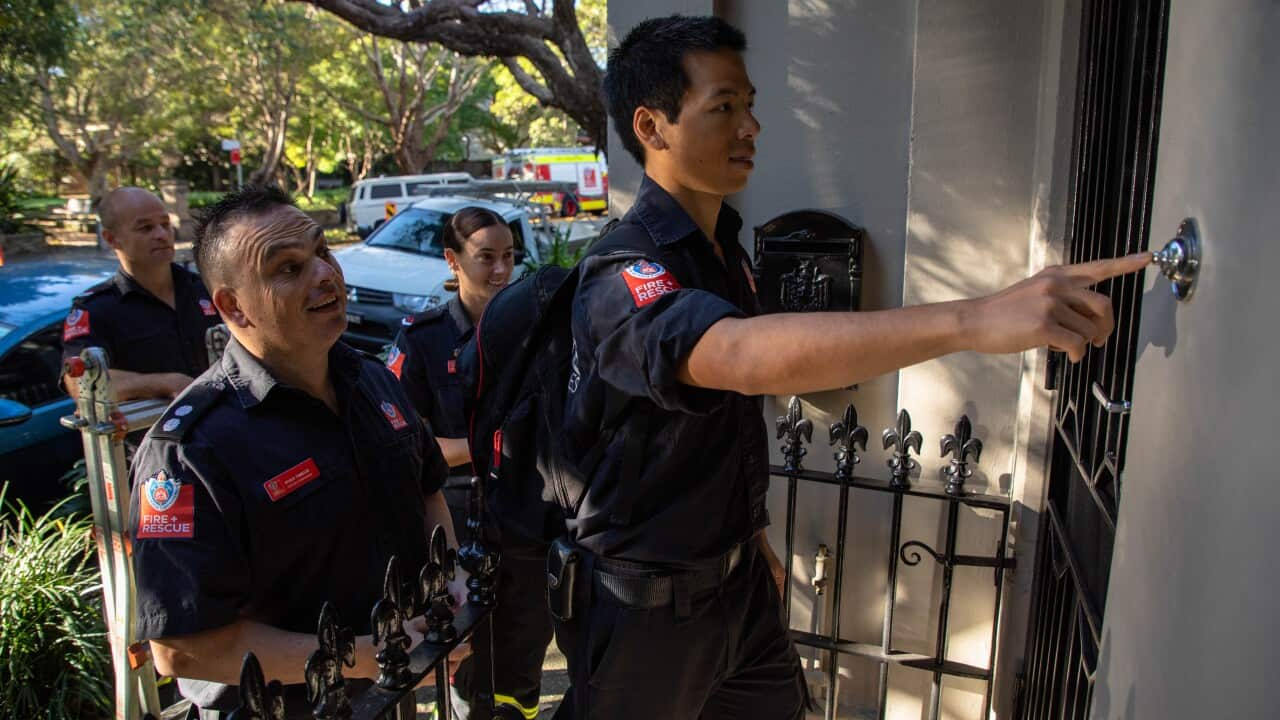In southwest Sydney, firefighters are going door to door on one Lakemba street, offering free smoke alarms and fire safety checks to anyone who wants them.
They have good reason to.
So far this winter, 13 people have died in home fires across NSW — three times the total death toll from last winter.

Firefighters in southwest Sydney spreading the word about fire safety. Source: Supplied / Fire and Rescue NSW
“It was a toddler who put a beanbag onto a heater. We recommend everyone keeps everything one metre from a heater,” Lakemba Station Officer Brendan Ford says.
“Unfortunately, in this instance, it didn't happen, and it did catch alight. Luckily the parents were there, and they had a working smoke alarm in the property.”

Firefighters from Lakemba fire station after conducting a home inspection. Source: Supplied / NSW Fire and Rescue
As the Lakemba Fire and Rescue team makes their way from house to house, they aren’t surprised to find several homes that either don’t have alarms, or don’t have them properly fitted.
“I noticed there was only one in the kitchen area and none in the hallways where the bedrooms were,” firefighter Demi-Lea Worrad says after inspecting one house.
“Generally, you wouldn't have one in the kitchen, because if you burn stuff it's always going to go off, but you definitely want to have one near the bedrooms, because we can't smell when we're asleep, and the only thing that would wake us up would be the alarm going off.”
Lifesaving education
The team aren’t just looking for working smoke alarms.
South-western Sydney is one of the most culturally diverse regions in the country, with people from more than 129 nationalities who speak about 200 languages living in Lakemba and the suburbs surrounding it.
As they make their way through each house, the firefighters are also trying to educate people about other potentially fatal fire hazards they might not realise they have inside their own homes.
“Things being too close to the heater, not cleaning the lint out of your dryer, sleeping with electric blankets on, overloading power boards, people putting double adaptors on power boards, and many people don’t know that a heater should always be plugged into a wall socket, because they draw a really large amount of power,” senior firefighter Kate Faith says.

A firefighter checks a smoke alarm. Source: Supplied / NSW Fire and Rescue
“So having a working smoke alarm and taking the time to test it each month is very different to what the outcome can be if you don’t have that early warning.”
Many of this winter’s fatalities have occurred at night.
We recommend everyone keeps everything one metre from a heater.Lakemba Station Officer Brendan Ford
Just last weekend, three people, including a 10-year-old boy, died in a house fire in Hinchinbrook.
The week before, a 60-year-old man from Bankstown died in his bedroom.
“We know that people who are older, people who are younger, people from lower socioeconomic areas, and sometimes people who don't speak English as a first language can be a barrier to receiving our fire safety information,” NSW Fire and Rescue’s Assistant Commissioner of Community Safety Trent Curtin says.
“It’s not necessarily linked to particular cultures, but unfortunately with cost pressures on families, we've seen people bringing outdoor heating into homes, or people bringing barbeques and cooking equipment into homes, and unfortunately that creates additional risk to our community.”
That’s led to an increase in cases of carbon monoxide poisoning, too.
Last week, six people from a Merrylands home were taken to hospital in the middle of the night for treatment after bringing a charcoal cooker inside their granny flat for warmth.
“When people think firefighters, they think bushfires, but we know more people die from fires in their homes than in bushfires or natural hazard events,” Assistant Commissioner Curtin says.
A nationwide problem
Friefighters have been spreading the word not only in Western Sydney, but across the city, and NSW is not alone in experiencing a particularly tragic fire season this winter.
Victoria has recorded 10 deaths and Western Australia five, while Tasmania and South Australia have had one fatality each.

A firefighter in Redfern, Sydney, speaks with a family about their fire safety plan. Source: Supplied / NSW Fire and Rescue
“Lots of immigrants don't speak English, but we find that the children or the younger generation are bilingual, so, not only can they absorb the information better, but then they pass it on and implement it to their parents and grandparents,” Fire Rescue Victoria’s Deputy Commissioner for Community Safety Directorate Michelle Young says.
“Culturally, we look at fire quite differently across the world, so we really need to educate different communities on what a good fire is and how to utilise fire within Australia.”
Deputy Commissioner Young says the program’s success has shown itself in several life-or-death situations, citing a recent fire in Melbourne where the children got their parents to evacuate their home and call 000.

Firefighters conducting a home visit Source: Supplied / NSW Fire and Rescue
“Coming from some countries, they see people in uniform and they are inherently scared, so we need to make sure they understand firefighters are good people and we're there to help them and save them.”

